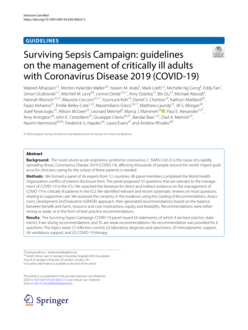Hello! You're looking at a policy document report on Overton
We track government policy, guidelines, think tank research, working papers and more to help our customers see the impact and influence of their work. Are you interested in seeing what information we have to offer? Request a free trial to our platform.
If you fund, produce or manage research or work to influence policy, we'd love to talk. Learn more on our homepage.

Identifiers
Overton ID
pubmedcentral-e636d9ed625f93398c8db0c8657338ae
Surviving Sepsis Campaign: guidelines on the management of critically ill adults with Coronavirus Disease 2019 (COVID-19)
Intensive Care Medicine
Background The novel severe acute respiratory syndrome coronavirus 2 (SARS-CoV-2) is the cause of a rapidly spreading illness, Coronavirus Disease 2019 (COVID-19), affecting thousands of people around the world. Urgent guidance for clinicians caring for the sickest of these patients is needed. Methods We formed a panel of 36 experts from 12 countries. All panel members completed the World Health Organization conflict of interest disclosure form. The panel proposed 53 questions that are relevant to the management of COVID-19 in the ICU. We searched the literature for direct and indirect evidence on the management of COVID-19 in critically ill patients in the ICU. We identified relevant and recent systematic reviews on most questions relating to supportive care. We assessed the certainty in the evidence using the Grading of Recommendations, Assessment, Development and Evaluation (GRADE) approach, then generated recommendations based on the balance between benefit and harm, resource and cost implications, equ...
Topics in this document
Heated humidified high-flow therapy
Modes of mechanical ventilation
Coronavirus disease 2019
Nitazoxanide
Mechanical ventilation
Shock (circulatory)
Tracheal intubation
Remdesivir
Intensive care medicine
Tocilizumab
Antibiotic
Randomized controlled trial
Pneumonia
Influenza
Immunoglobulin therapy
Laryngoscopy
Fluid replacement
Sepsis
Volume expander
Intensive care unit
Evidence-based medicine
Ribavirin
Infection
Middle East respiratory syndrome
Antiviral drug
Severe acute respiratory syndrome
NIOSH air filtration rating
Passive immunity
Extracorporeal membrane oxygenation
Personal protective equipment
Related SDGs
SDG 3: Good Health and Well-being ...
SDG 3: Good Health and Well-being
Target 3.3
End the epidemics of AIDS, tuberculosis, malaria and neglected tropical diseases and combat hepatitis, water-borne diseases and other communicable diseases
Target 3.d
Strengthen the capacity of all countries, in particular developing countries, for early warning, risk reduction and management of national and global health risk
Cites research funded by
7
NIHR (November 2024)
1
Assistance Publique Hôpitaux de Paris
1
Assistance Publique - Hôpitaux de Paris
1
Northern Ireland Health and Social Care Research and Development Division
1
Fonds de Recherche du Québec - Santé
1
Young Scientists Fund
1
National Natural Science Foundation of China-Zhejiang Joint Fund for the Integration of Industrialization and Informatization
2
National Natural Science Foundation of China
1
Sichuan Science and Technology Agency
1
National University of Singapore
1
Ministry of Education - Singapore
1
Sichuan Science and Technology Program
1
Chinese University of Hong Kong's
1
Chinese University of Hong Kong
1
National Key R&D Program of China
1
Nanjing Agricultural University
1
Bayer
1
Boehringer Ingelheim
4
Wellcome Trust
3
Medical Research Council
2
National Institute for Health Research (NIHR)
1
GlaxoSmithKline
1
Innovate UK
5
MRC
1
H2020_REST (Special project, May 2022)
1
H2020_REST_ThirdPillar (Special project, May 2022)
1
French Ministry of Health
1
Cancer Research UK
2
Ministère des Affaires Sociales et de la Santé
6
NIH (Special project, May 2022)
1
National Heart, Lung, and Blood Institute
1
National Eye Institute
4
National Institute of Allergy and Infectious Diseases
2
National Institute on Minority Health and Health Disparities
1
World Health Organization
1
HHS
1
CCR NIH HHS
1
NCI NIH HHS
1
Intramural NIH HHS
1
Division of Intramural Research, National Institute of Allergy and Infectious Diseases
1
National Institute for Health Research
1
National Institute for Health and Care Research
1
Zhejiang University
1
Ministry of Science and Technology of the People's Republic of China
1
Bill and Melinda Gates Foundation
4
OpenAlex NIH DOIs (April 2024)
4
National Institutes of Health
1
Infectious Diseases Society of America
2
Health Resources and Services Administration
1
Consejo Nacional de Ciencia y Tecnología
... and others
Citations
Cited by 81
other policy documents
(64 of them are from other policy sources)
